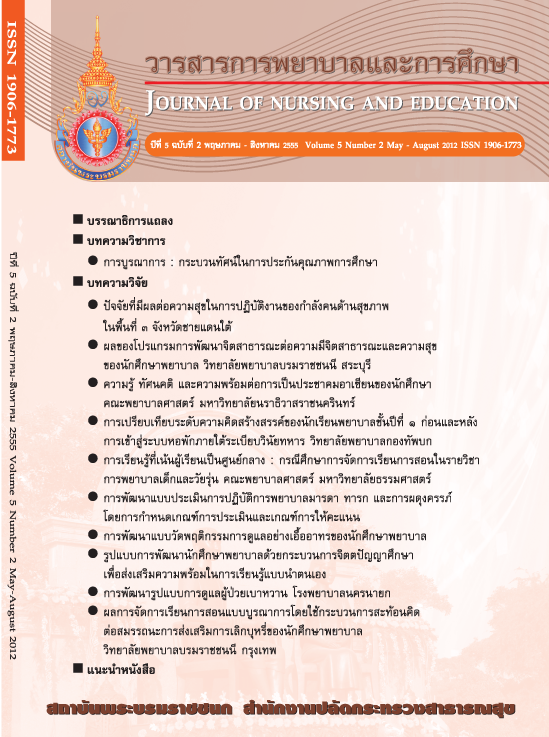การเรียนรู้ที่เน้นผู้เรียนเป็นศูนย์กลาง : กรณีศึกษา การจัดการเรียนการสอนในรายวิชาการพยาบาลเด็กและวัยรุ่น คณะพยาบาลศาสตร์ มหาวิทยาลัยธรรมศาสตร์
คำสำคัญ:
Student-Centered Learning, Instructional Modelบทคัดย่อ
บทคัดย่อ
ตามพระราชบัญญัติการศึกษาแห่งชาติ การเรียนรู้ที่เน้นผู้เรียนเป็นศูนย์กลางเป็นกระบวนการเรียนรู้ ที่ถูกให้ความสำคัญอย่างมาก เนื่องจากเป็นกระบวนการจัดการศึกษาที่ส่งเสริมให้ผู้เรียนสามารถพัฒนา ตามธรรมชาติและเต็มศักยภาพ เป็นวิธีการจัดการเรียนการสอนที่มีความสำคัญและสอดรับกับหลักสูตร การศึกษาพยาบาล เนื่องจากเน้นกระบวนการคิด และการปฏิบัติจริงนำไปสู่การประยุกต์ใช้โดยผู้เรียน
สร้างองค์ความรู้ได้ด้วยตนเอง ส่งเสริมให้เป็นผู้ใฝ่เรียนรู้ตลอดชีวิต อีกทั้งช่วยพัฒนาสมรรถนะเชิงวิชาชีพ พยาบาล ในการจัดการการเรียนรู้จะต้องคำนึงถึงองค์ประกอบที่สำคัญ 4 อย่าง ได้แก่ 1. ผู้เรียน 2. ผู้สอน 3. กระบวนการ และ 4. การประเมินผลสัมฤทธิ์ รูปแบบการจัดการเรียนรู้ที่เน้นผู้เรียนเป็นศูนย์กลาง มีหลายรูปแบบ ตัวอย่างเช่น การเรียนรู้แบบใช้ปัญหาเป็นหลัก การเรียนรู้เป็นรายบุคคล และการเรียนรู้ แบบแสวงหาความรู้ด้วยตนเอง เป็นต้น ในบทความนี้จะนำเสนอตัวอย่างของการจัดการสอนด้วยวิธีดังกล่าว ในรายวิชาการพยาบาลเด็กและวัยรุ่น ที่คณะพยาบาลศาสตร์ มหาวิทยาลัยธรรมศาสตร์ สิ่งที่พบจาก การจัดการสอนด้วยรูปแบบนี้มีผลดีต่อการเรียนรู้ของนักศึกษาช่วยให้สนใจในการเรียนมากขึ้น ช่วยพัฒนาทักษะการคิดวิเคราะห์ ทักษะการแก้ปัญหา และเกิดความสามารถในการเรียนรู้ด้วยตนเอง แต่ในขณะเดียวกันก็มีสิ่งที่ควรพัฒนาในด้านผู้สอน ผู้เรียน และทรัพยากรการเรียนรู้ พร้อมทั้งนำเสนอแนว ทางการพัฒนารูปแบบการสอน เพื่อแลกเปลี่ยนประสบการณ์ในการจัดหลักสูตรการศึกษาพยาบาล ที่มุ่งพัฒนาผู้เรียนเป็นสำคัญ สร้างบัณฑิตพยาบาลที่มีศักยภาพให้แก่วงการวิชาชีพต่อไป
Abstract
According to the National Education ACT, student-centered learning is an important instructional process which is mostly focused because it fosters learners’ ability to naturally develop their full potential. Corresponding with the nursing curriculum, this method becomes significant as it emphasizes thinking process and actual practice, which results in the application and construction of knowledge by themselves. Moreover, the student-centered learning supported both lifelong learning and developed competencies of professional nurses. During the implementation process, four components need to be taken into consideration: 1) learners; 2) instructors; 3) process; and 4) evaluation. Some examples of student-centered learning models include problem-based learning, individual study, and self-study. This paper presents some examples of the models aforementioned in the nursing care of children and adolescents course offered by the Faculty of Nursing, Thammasat University. The findings indicated that these instructional models benefited students’ learning by increasing their interested in learning, strengthening their thinking, analytic, and problem-solving skills, and promoting self directed learning. At the same time, it is essential for learning successful outcome by the development of the instructors, learners, and learning resources existed. This study then proposed certain ways to improve the instructional model and shared some experiences with implementing the nursing curriculum that aimed fundamentally at empowering learners and preparing potential nursing graduates for the professions.





